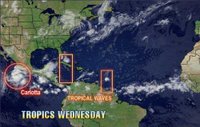The next tropical wave to be concerned with is roughly along 70 west, south of 20 north. It is moving west-northwestward at about 15 knots. There are no signs of organization with this wave at the moment and shear caused by westerly winds aloft will prevent any development along this wave in the near future. The wave is causing showers and thunderstorms in Puerto Rico and the Virgin Islands Thursday night that will reach Hispaniola Friday. This wave will eventually reach South Florida by Sunday.
A weak wave is around 54 west, south of 12 north. There are a few scattered showers from this system, but no development is expected.
Another tropical wave is out over the open Atlantic to the southwest of the Cape Verde Islands along 30 west, south of 15 north. There appears to be an area of low pressure along this wave centered near 27 west and 13 north, as evidenced by a swirl of clouds on satellite pictures of the region. While in minimal shear at this point it will continue to head toward a region where more shear is expected. Development is not expected.
Another wave is moving through western Africa and should form another Atlantic tropical wave later Friday.




